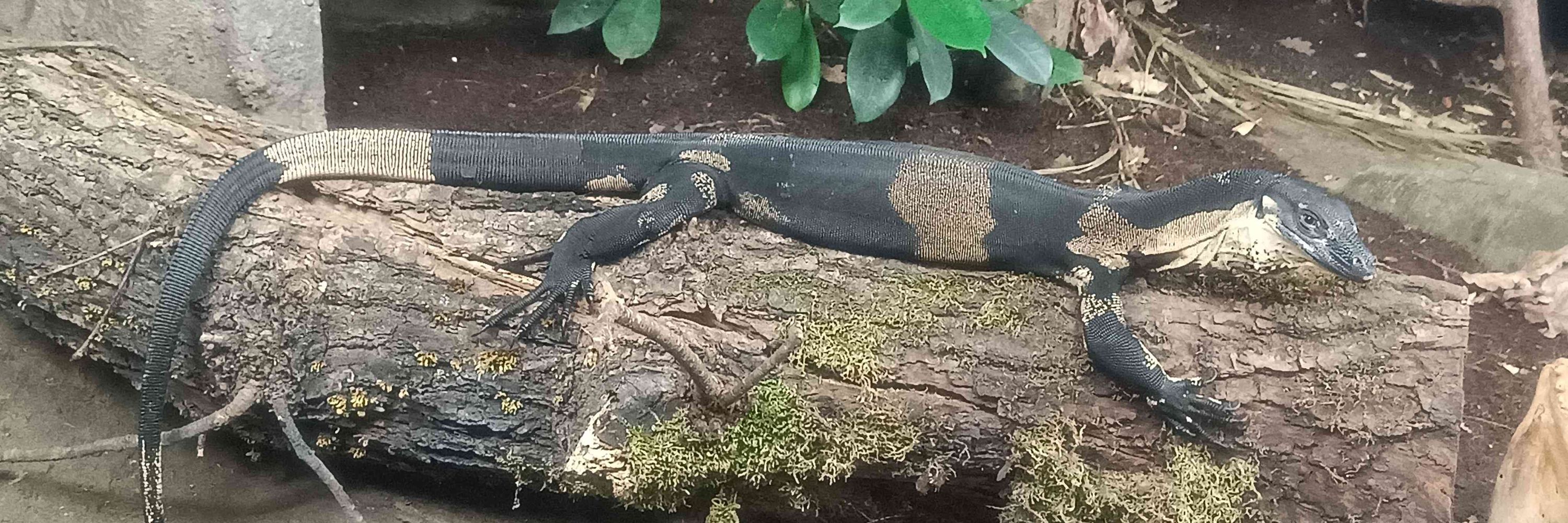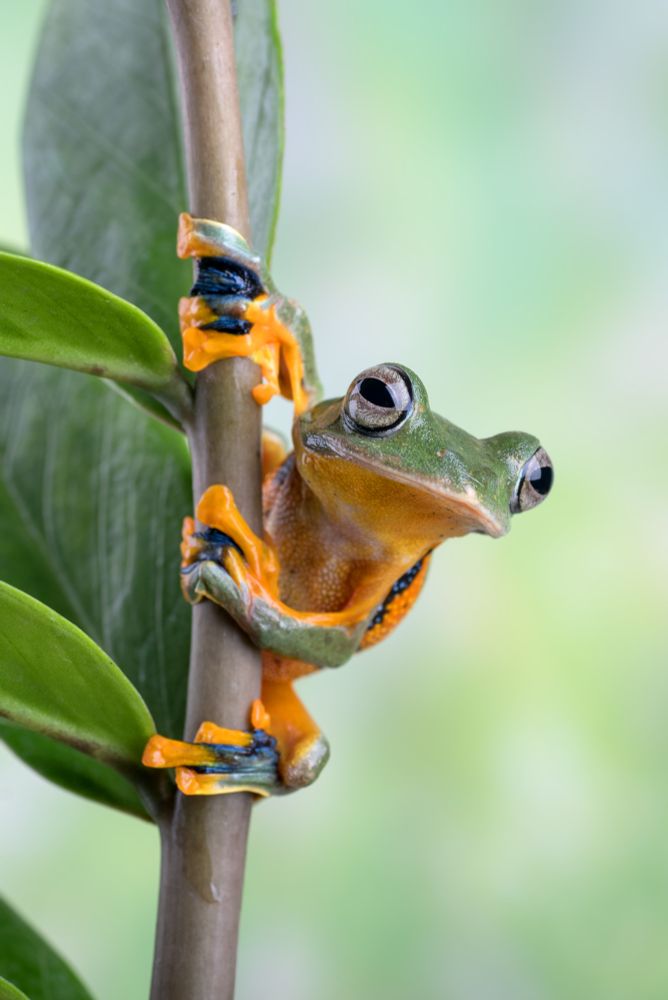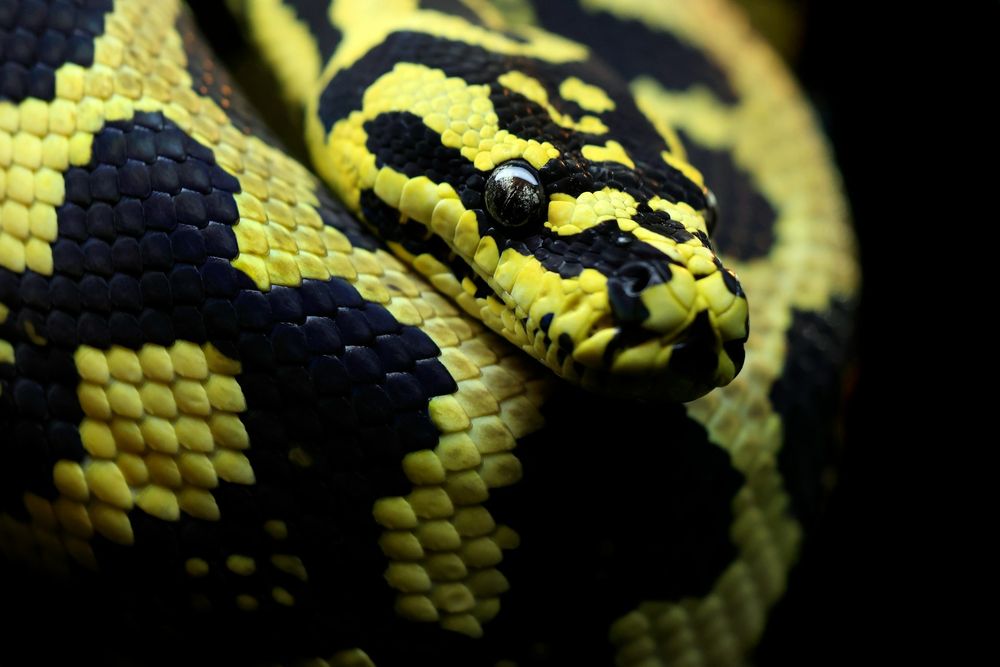
The monitor lizard in my banner is a Varanus varius in Copenhagen Zoo.
Max size for males 5 cm (2"), for females 7 cm (2.75").
If sensing danger, tadpoles may hatch early and drop into the water below.
Found from Honduras down to northern Colombia.
Considered Least Concern by the IUCN.
📷by kuritafsheen77 on Freepik

Max size for males 5 cm (2"), for females 7 cm (2.75").
If sensing danger, tadpoles may hatch early and drop into the water below.
Found from Honduras down to northern Colombia.
Considered Least Concern by the IUCN.
📷by kuritafsheen77 on Freepik
Max carapace size 23 cm (9.1").
Found in southeastn Canada and in the north and northeastern US.
Threatened by habitat fragmentation/destruction.
Considered Endangered by the IUCN.
📷by rfotostock on Pixabay

Max carapace size 23 cm (9.1").
Found in southeastn Canada and in the north and northeastern US.
Threatened by habitat fragmentation/destruction.
Considered Endangered by the IUCN.
📷by rfotostock on Pixabay
Max size: males 4.6 m (15'1"), females 3 m (9'10").
Found from North Carolina in the northeast across to Texas and occasionally even into Mexico.
Considered Least Concern by the IUCN.
📷by FPV_Drones on Pixabay

Max size: males 4.6 m (15'1"), females 3 m (9'10").
Found from North Carolina in the northeast across to Texas and occasionally even into Mexico.
Considered Least Concern by the IUCN.
📷by FPV_Drones on Pixabay
Max. size ~40 cm (~15.7").
Found in grasslands in only three provinces in South Africa
Considered Vulnerable by the IUCN.
📷by Cifer88 on Pixabay

Max. size ~40 cm (~15.7").
Found in grasslands in only three provinces in South Africa
Considered Vulnerable by the IUCN.
📷by Cifer88 on Pixabay
Max size 182 cm (~6').
Found in southeastern United States.
Eats rodents, bird eggs as well as amphibians and reptiles.
Considered Least Concern by the IUCN.
📷by mbquinn on Pixabay

Max size 182 cm (~6').
Found in southeastern United States.
Eats rodents, bird eggs as well as amphibians and reptiles.
Considered Least Concern by the IUCN.
📷by mbquinn on Pixabay
Max. size 4.2cm (1.7"). Females are slightly larger than males.
Found in Nicaragua, Costa Rica, Panama and Colombia.
Males fight for territories during mating season.
Considered Least Concern by the IUCN.
📷by Alejandro Orozco on Pexels

Max. size 4.2cm (1.7"). Females are slightly larger than males.
Found in Nicaragua, Costa Rica, Panama and Colombia.
Males fight for territories during mating season.
Considered Least Concern by the IUCN.
📷by Alejandro Orozco on Pexels
Max. size 1.5 m (4'11"). Females are noticeably smaller than males.
Eats algae in the sea at depths of up to 30 m (98').
Found on the Galapagos Islands.
Considered Vulnerable by the IUCN.
📷by pen_ash on Pixabay

Max. size 1.5 m (4'11"). Females are noticeably smaller than males.
Eats algae in the sea at depths of up to 30 m (98').
Found on the Galapagos Islands.
Considered Vulnerable by the IUCN.
📷by pen_ash on Pixabay
Max. size 330 cm (10'10").
Venomous.
Eats birds, frogs, mammals, reptiles, snakes and even spiders.
Found in Northern, western and central Australia.
Considered Least Concern by the IUCN.
📷by David Clode on Unsplash

Max. size 330 cm (10'10").
Venomous.
Eats birds, frogs, mammals, reptiles, snakes and even spiders.
Found in Northern, western and central Australia.
Considered Least Concern by the IUCN.
📷by David Clode on Unsplash
Found in China, Indonesia, Laos, Malaysia, Thailand and Vietnam.
Constructs foam nests above standing water.
Max size for males 5.3 cm (2.1"), for females 7.9 cm (3.1").
Considered Least Concern by the IUCN.
📷by kuritafsheen77 on Freepik.

Found in China, Indonesia, Laos, Malaysia, Thailand and Vietnam.
Constructs foam nests above standing water.
Max size for males 5.3 cm (2.1"), for females 7.9 cm (3.1").
Considered Least Concern by the IUCN.
📷by kuritafsheen77 on Freepik.
Max. length 100 cm (39.4").
Found on the island of New Guinea as well as on several islands in the vicinity.
Eats large insects/invertebrates, small birds and mammals.
Considered Least Concern by the IUCN.
📷by wirestock on Freepik

Max. length 100 cm (39.4").
Found on the island of New Guinea as well as on several islands in the vicinity.
Eats large insects/invertebrates, small birds and mammals.
Considered Least Concern by the IUCN.
📷by wirestock on Freepik
Max. size males 60 cm (23.6"), females 81 cm (31.9").
Found in Bhutan, Cambodia, China, Hong Kong, Indonesia, Laos, Macau, Myanmar, Nepal, Thailand and Vietnam.
Considered Least Concern by the IUCN.
📷by kuritafsheen77 on Freepik

Max. size males 60 cm (23.6"), females 81 cm (31.9").
Found in Bhutan, Cambodia, China, Hong Kong, Indonesia, Laos, Macau, Myanmar, Nepal, Thailand and Vietnam.
Considered Least Concern by the IUCN.
📷by kuritafsheen77 on Freepik
Max. size for males 80 mm (3.1"), for females 100 mm (3.9").
Eats mostly insects and spiders.
Found on the island of Borneo.
Considered Least Concern by the IUCN.
📷by kuritafsheen77 on Freepik.

Max. size for males 80 mm (3.1"), for females 100 mm (3.9").
Eats mostly insects and spiders.
Found on the island of Borneo.
Considered Least Concern by the IUCN.
📷by kuritafsheen77 on Freepik.
Max size for males 150 cm (4'11"), for females 91 cm (3').
Omnivorous.
Found in Argentina, Bolivia, Brazil, Paraguay and Uruguay.
Used for bushmeat and in the leather trade.
Considered Least Concern by the IUCN.
📷by evandroanjos on Pixabay

Max size for males 150 cm (4'11"), for females 91 cm (3').
Omnivorous.
Found in Argentina, Bolivia, Brazil, Paraguay and Uruguay.
Used for bushmeat and in the leather trade.
Considered Least Concern by the IUCN.
📷by evandroanjos on Pixabay
Earlier today, I got my Covid and Flu shot.
Earlier today, I got my Covid and Flu shot.
Anabantoids and other freshwater aquarium fish
Books
Collecting strange facts
Good quality dark chocolate
Herps (reptiles and amphibians)
Italian food
Languages
Most things science
Playing billiards
Single malt whisky
London
Snakes
The beach
The woods
Bob Dylan
TTRPGs
Lilacs
Hawaiian shirts
Blueberries
Reservation Dogs
Fountain pens
James Frazer
Guitars
Cats
William James
Watercolors
Dredge
Irish music
Werewolves
The Verve Pipe
Anabantoids and other freshwater aquarium fish
Books
Collecting strange facts
Good quality dark chocolate
Herps (reptiles and amphibians)
Italian food
Languages
Most things science
Playing billiards
Single malt whisky
This subspecies has a max. size of ~2.6 m (~8'6"), but is usually smaller. Females tend to be larger than males.
Found in rainforests in northeastern Queensland, Australia.
📷by david-clode-unsplash

This subspecies has a max. size of ~2.6 m (~8'6"), but is usually smaller. Females tend to be larger than males.
Found in rainforests in northeastern Queensland, Australia.
📷by david-clode-unsplash
Max. size for males 62 mm (2.4"), for females 76 mm (3").
Found in forested areas of Thailand, Peninsular Malaysia and on the island of Sumatra in Indonesia.
Considered Least Concern by the IUCN.
📷by kuritafsheen77 on Freepik

Max. size for males 62 mm (2.4"), for females 76 mm (3").
Found in forested areas of Thailand, Peninsular Malaysia and on the island of Sumatra in Indonesia.
Considered Least Concern by the IUCN.
📷by kuritafsheen77 on Freepik
Max. length 37 cm (14.6"), 2/3 of which is the tail.
Found from Iran and Afghanistan in the west to the Philippines in the east. It has been introduced in many places around the world.
Considered Least Concern by the IUCN.
📷by Erik_Karits on Pixabay.

Max. length 37 cm (14.6"), 2/3 of which is the tail.
Found from Iran and Afghanistan in the west to the Philippines in the east. It has been introduced in many places around the world.
Considered Least Concern by the IUCN.
📷by Erik_Karits on Pixabay.
Max size 155 cm (5'1").
Ambush predator. At 5 cm (2") it has the longest fangs of any snake.
Found in forested areas and grasslands in large parts of Sub-Saharan Africa.
Considered Vulnerable by the IUCN.
📷byConnor Padraic Mallon, Smithsonian's National Zoo

Max size 155 cm (5'1").
Ambush predator. At 5 cm (2") it has the longest fangs of any snake.
Found in forested areas and grasslands in large parts of Sub-Saharan Africa.
Considered Vulnerable by the IUCN.
📷byConnor Padraic Mallon, Smithsonian's National Zoo
Max. size 64 mm (2.5"). Females tend to be larger than males.
Found in the US from Texas in the west, through Florida in the southeast and as far northeast as New Jersey.
Considered Least Concern by the IUCN.
📷by Brett_Honslow on Pixabay

Max. size 64 mm (2.5"). Females tend to be larger than males.
Found in the US from Texas in the west, through Florida in the southeast and as far northeast as New Jersey.
Considered Least Concern by the IUCN.
📷by Brett_Honslow on Pixabay
Max. size 20.3 cm (8"), Males tend to be slightly larger than females.
Found in the southeastern USA. Has been introduced around the Pacific, in the Caribbean, in Mexico and in California.
Considered Least concern by the IUCN.
📷by Ray_Shrewsberry on Pixabay

Max. size 20.3 cm (8"), Males tend to be slightly larger than females.
Found in the southeastern USA. Has been introduced around the Pacific, in the Caribbean, in Mexico and in California.
Considered Least concern by the IUCN.
📷by Ray_Shrewsberry on Pixabay
Max size more than 200 cm (6'6.7").
Found in northern and central China, Korea, eastern Mongolia and eastern Russia.
Considered Least Concern by the IUCN.
📷by plesnercph

Max size more than 200 cm (6'6.7").
Found in northern and central China, Korea, eastern Mongolia and eastern Russia.
Considered Least Concern by the IUCN.
📷by plesnercph
Max size males ~4 cm (~1.6"), females ~4.5 cm (~1.8").
Females may physically fight over a calling male.
Found in southern Suriname and across the border with Brazil.
Not evaluated by the IUCN.
📷by William Warby on Pexels

Max size males ~4 cm (~1.6"), females ~4.5 cm (~1.8").
Females may physically fight over a calling male.
Found in southern Suriname and across the border with Brazil.
Not evaluated by the IUCN.
📷by William Warby on Pexels
May be part of a species complex of closely related species difficult to tell apart.
Max. size ~38 cm (~15").
Found in in eastern, central and southern Africa.
Considered Least Concern by the IUCN.
📷Lisa Stockton on Unsplash

May be part of a species complex of closely related species difficult to tell apart.
Max. size ~38 cm (~15").
Found in in eastern, central and southern Africa.
Considered Least Concern by the IUCN.
📷Lisa Stockton on Unsplash

